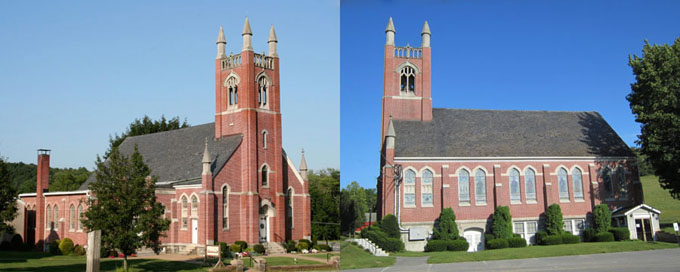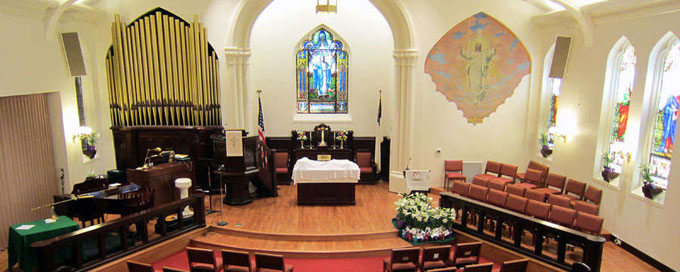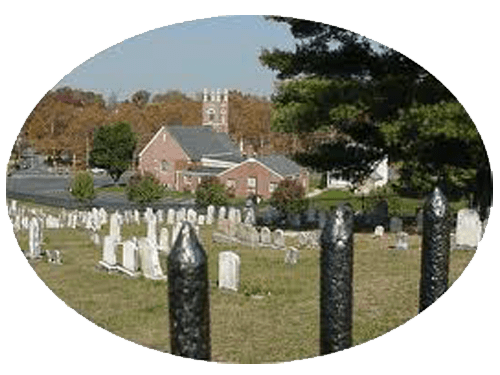Bern Reformed United Church of Christ
The Symbols of Bern Union Church
In 1974, Earl H Reeser, a member of Bern Reformed Church, assembled a booklet explaining The Symbols of Bern Union Church. He lists 97 symbols and explains their value. Below are some excerpts explaining some of these symbols.


Bells
The Bells of Bern were cast in 1918 by McShane Bell Foundry, Co., Baltimore, MD. The bells were rung on Saturday at 6 P.M. for Sunday morning services. 15 minutes before services or as now, at the start of the services.
- Death of a member, at which time, his age was tolled.
- Funerals – tolling of the bells was started when the funeral approached the church.
- New Year – As the clock struck midnight, the bells were rung to announce the beginning of a New Year.
Spires
As we approach the church, we behold the steeple, with four spires pointing heavenward. These four spires are to signify that God loves the world, reconciles the world unto himself through worship, meditation, prayers, and hymns of the people in the church below.
Altar
We behold the Altar as a large appointment, which is shaped like a tomb, reminding us of the catacombs, when Christians celebrated the Lord’s Supper upon the tombs of Martyrs. The Altar should symbolize to us Christ’s sacrificial death, which is to be further illustrated by the bread and wine, as the body and blood of our Lord and Saviour. A special chalice, like the one Christ used at His Last Supper is used. The Altar is the throne of God in His house. It is an everlasting symbol of His spiritual presence in the church.
Jesus Christ Stained-Glass Window
Above the Altar is a stained-glass window showing Jesus Christ in the garden with open outstretched hands which to me suggests that He is saying "Come unto me all ye that labor and are heavy laden and I will give you a rest."
Stained-Glass Windows
There is a multitude of stained-glass windows throughout the church. Some depict Biblical characters including David, Moses, St. John, St. Luke, St. Mark, St. Matthew, St. Paul, St. Peter. Others show historical figures like Ulrich Zwingli and Martin Luther. Important church symbols like the Ten Commandments, Holy Bible, Cross, Chalice, Descending Dove, Lyre, Angels, Crown, Oil Lamp, Grapes, and Sheaf of Grain are displayed in some of the windows. Earl Reeser describes each window and the importance of the figures and items that appear in them.
Colors
Earl Reeser explains the symbolic nature of the colors displayed throughout the church season as well as the color of the garments worn by the figures in the stained-glass windows.
White: Christmas, Sundays after Christmas to the transfiguration of our Lord Jesus Christ is the symbol of the Creator, light, joy, purity, innocence, glory, and perfection.
Violet: pre-Lenten Sundays, all Sundays in Lent, up to Good Friday – denotes mourning and penitence, also humility, suffering, sympathy, and fasting.
Black: Good Friday, Memorial Day – denotes grief and sorrow.
White: Easter to after Ascension Day, Festival of the Holy Trinity.
Purple: a regal color, referring to the triumphal entry of the King of Kings.
Red: Pentecost, Harvest festival, Reformation Sunday, Thanksgiving, depicts the divine zeal of the Pentecost, and to the blood of the Martyrs of the Church.
Green: After Trinity – The universal color of nature, signifying hope.
Gold: As seen on the fringes of the hangings, refers to worth, virtue, the glory of God, and the Christian might.
Conclusion
All in all, Earl Reeser describes over 90 different symbols displayed throughout Bern Church. Some are quite obvious, some have been stored, and some are hiding in plain sight. His explanations enlighten us on the importance and value of symbols. Booklets are available at the church.
Bern Old Graveyard Records

© 2013, Bern Reformed United Church of Christ. All rights reserved. Site Design: Jeff Heiser